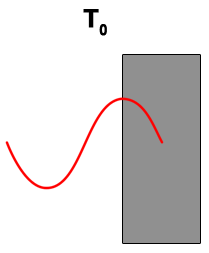Thermal lag
In this article we’ll discuss thermal lag, an important value to take under consideration when analyzing walls and, more in general, building structures. We’ll use our thermal bridge FEM software, Mold Simulator Dynamic, to compute thermal lag in accordance with EN ISO 13786.
In case of simple structures (i.e. a set of homogeneous layers) thermal lag can be analytically evaluated using EN ISO 13786 formulae, but in more general situations a FEM simulation is required.
Thermal lag represents a structure’s thermal mass in terms of time; to make it simple, it’s how long it takes to the heat wave to pass through a building structure.
 |  |
| T0: time when temperature is at its maximum on external surface. A sinusoidal heat wave is applied to external surface. | T1: time when temperature is at its maximum on internal surface. The heat wave has been delayed and faded. |
Thermal lag = T1 – T0 in hours
To have a better understanding of this subject please download this sample for Mold Simulator Dynamic:
![]()
You need Mold Simulator Viewer (free) to open it.

